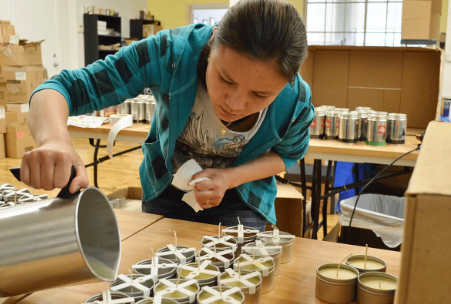In the crowded world of scented candles, standing out is a challenge. With countless brands offering a variety of fragrances, shapes, and designs, manufacturers must continuously innovate to capture the attention and loyalty of consumers. The fragrance revolution in the scented candle industry is characterized by a relentless pursuit of unique scents, sustainable practices, and technological advancements. This blog explores how manufacturers are pushing the boundaries of creativity and technology to differentiate themselves in a saturated market.
1. The Quest for Unique Fragrances
1.1. Unconventional Scent Profiles
- Unconventional Scent Profiles: One of the most effective ways to stand out in the scented candle market is by offering unique and unconventional fragrances. While traditional scents like vanilla, lavender, and sandalwood remain popular, there is a growing demand for more exotic and complex scent profiles. Manufacturers are experimenting with blends that evoke specific moods, memories, or even places. For example, candles with scents inspired by exotic locations, like a Moroccan spice market or a coastal breeze, offer consumers a sensory escape.
1.2. Seasonal and Limited-Edition Collections
- Seasonal and Limited-Edition Collections: Another strategy is the introduction of seasonal and limited-edition collections. These candles are often designed to celebrate holidays, seasons, or special events and come with exclusive fragrances that are only available for a limited time. This not only creates a sense of urgency and exclusivity but also allows brands to experiment with new scent combinations without committing to them long-term. For instance, a winter collection might feature scents like “Cinnamon Spice” or “Frosted Pine,” evoking the cozy and festive atmosphere of the holiday season.
1.3. Personalization and Customization
- Personalization and Customization: The ability to personalize and customize scented candles is another innovation gaining traction. Consumers increasingly seek products that reflect their individuality and personal tastes. Some manufacturers offer custom fragrance blending services, allowing customers to create their own unique scent combinations. Additionally, personalized labels, custom engravings, and bespoke packaging options are becoming popular, especially for gifts and special occasions. This level of customization enhances the emotional connection between the consumer and the product, making it more than just a candle—it’s a personalized experience.
2. Sustainability and Ethical Practices
2.1. Sustainable Ingredients
- Sustainable Ingredients: As environmental consciousness grows, consumers are becoming more mindful of the ingredients in their products. Scented candle manufacturer are responding by prioritizing sustainable and eco-friendly ingredients. This includes using natural waxes such as soy, coconut, and beeswax, which are biodegradable and renewable. Additionally, many brands are opting for sustainably sourced essential oils and avoiding synthetic fragrances that may contain harmful chemicals. By focusing on sustainable ingredients, manufacturers not only reduce their environmental impact but also cater to a growing market of eco-conscious consumers.
2.2. Eco-Friendly Packaging
- Eco-Friendly Packaging: Packaging plays a crucial role in the sustainability of scented candles. Manufacturers are increasingly adopting eco-friendly packaging solutions, such as recyclable, biodegradable, and reusable materials. For example, some companies use glass jars that can be repurposed after the candle has burned out, or cardboard packaging made from recycled materials. These efforts not only appeal to environmentally aware consumers but also contribute to a brand’s overall sustainability narrative.
2.3. Ethical Sourcing and Fair Trade
- Ethical Sourcing and Fair Trade: Beyond sustainability, ethical sourcing practices are becoming a key focus for many candle manufacturers. This includes ensuring that raw materials, such as wax and essential oils, are sourced from suppliers who adhere to fair trade practices and support fair wages and safe working conditions. By choosing ethically sourced ingredients, brands can differentiate themselves and build trust with socially conscious consumers who prioritize transparency and ethical values.
3. Technological Advancements in Candle Manufacturing
3.1. Smart Candles and Digital Integration
- Smart Candles and Digital Integration: The intersection of technology and scented candles has given rise to smart candles—candles equipped with digital features such as Bluetooth connectivity, app control, and even built-in speakers. These candles can be controlled via smartphone apps, allowing users to adjust the intensity of the fragrance, set timers, and create custom scent profiles. Some smart candles even come with features like LED lights that change color, adding an extra dimension to the sensory experience. This digital integration not only adds convenience but also enhances the overall ambiance and mood-setting capabilities of candles.
3.2. Advanced Scent Delivery Systems
- Advanced Scent Delivery Systems: Innovations in scent delivery systems are also revolutionizing the candle industry. Traditional candles rely on the flame to release fragrance, but new technologies are emerging that offer alternative methods. For instance, some manufacturers are experimenting with cold diffusion systems that release scent without the need for heat, making them safer and more versatile. These systems can be integrated into smart home devices, allowing for automated and controlled scent dispersal throughout the day.
3.3. 3D Printing and Customization
- 3D Printing and Customization: 3D printing technology is opening up new possibilities for customization and design in candle manufacturing. Manufacturers can now create intricate and unique candle shapes that would be difficult or impossible to achieve with traditional molding techniques. This technology also allows for on-demand production, reducing waste and allowing for greater flexibility in product offerings. For example, consumers can order candles in custom shapes, such as personalized initials or bespoke designs, making for unique and memorable gifts.
4. Marketing and Branding Strategies
4.1. Emphasis on Brand Storytelling
- Emphasis on Brand Storytelling: In a saturated market, a compelling brand story can set a brand apart. Many candle manufacturers are focusing on storytelling as a key component of their marketing strategy. This includes sharing the brand’s history, values, and mission, as well as the inspiration behind specific product lines. A strong narrative can create an emotional connection with consumers and foster brand loyalty. For example, a brand that emphasizes its commitment to sustainability and ethical practices can attract environmentally conscious customers who align with those values.
4.2. Collaborations and Partnerships
- Collaborations and Partnerships: Collaborations with other brands, artists, or influencers can also help manufacturers stand out. These partnerships can result in unique, limited-edition products that draw in new audiences and generate buzz. For instance, a candle brand might collaborate with a popular lifestyle influencer to create a signature scent, leveraging the influencer’s following to boost brand visibility. Such collaborations not only expand the brand’s reach but also add a layer of exclusivity and desirability to the products.
4.3. Social Media and Online Presence
- Social Media and Online Presence: In today’s digital age, a strong online presence is crucial. Scented candle manufacturers are increasingly leveraging social media platforms to showcase their products, share behind-the-scenes content, and engage with customers. Platforms like Instagram and Pinterest, with their visual focus, are particularly effective for highlighting the aesthetic appeal of candles and their packaging. Additionally, e-commerce platforms and direct-to-consumer websites allow brands to reach a global audience and offer personalized shopping experiences.
Conclusion
The scented candle industry is undergoing a fragrance revolution, driven by innovation, sustainability, and technology. As manufacturers strive to differentiate themselves in a saturated market, they are exploring new and unconventional scent profiles, embracing eco-friendly practices, and integrating cutting-edge technology into their products. The result is a diverse and dynamic landscape where consumers have more choices than ever before. Whether through unique fragrances, smart candle features, or compelling brand stories, the industry’s leading players continue to push the boundaries, creating products that not only delight the senses but also resonate with consumers’ values and lifestyles. As the market evolves, the fragrance revolution shows no signs of slowing down, promising an exciting future for scented candle enthusiasts and manufacturers alike.





